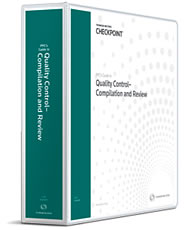We're available Monday to Friday from 8 a.m. to 6 p.m. eastern time.
Need help right now? Call 1-800-431-9025.

The 2025 Guide to Quality Control: Compilation and Review will be available in June 2025. Pre-order today.

Get a streamlined approach for firms that provide only compilation and review services to establish and maintain a quality management (QM) system and pass peer review with PPC's Guide to Quality Management- Compilation and Review.
The Guide incorporates the QM standards, the AICPA peer review requirements, and includes:
Contact Your Account Manager to learn more about our Checkpoint online solutions